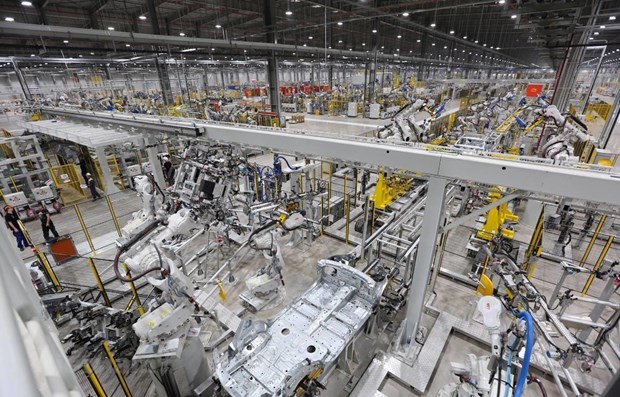Growth of many sectors slows down in Q1: VEPR
 Illustrative image (Photo: VietnamPlus)
Illustrative image (Photo: VietnamPlus)
Hanoi (VNA) – The future of the Vietnamese economy in 2019may become more unstable due to impacts from shocks in the international market, according to the Vietnam Institute for Economic and Policy Research (VEPR).
According to Prof. Dr. Pham The Anh, a senior economist from the VEPR, the economic growth of 6.79 percent in the first quarter was lower than that in the same period last year (7.45 percent). The growth speed of a number of sectors has slowed down, while the Purchasing Managers' Index (PMI) dropped to a low level, and the fall in the number of jobs and increasing inventory considerably reduced the optimism of producers.
Growth sees signs of standstill
A report from the VEPR showed that in the first quarter of 2019, industrial production index rose 9.2 percent, while consumption index of the manufacturing-processing sector increased 8 percent, but the expansions were lower than those in the first quarter of 2018. Meanwhile, the average inventory index in the period was 15.6 percent.
These figures manifested a risk of temporary stagnation in production, warned Anh.
He analysed that growth structure of the economy continued to depend on the foreign direct investment (FDI) sector and its exports, while the equitisation of State-owned enterprises faced a standstill.
[100 Vietnamese firms chosen to list products on Amazon]
A report from the General Statistics Office pointed out that 43,500 new firms were set up and resumed their activities in the first quarter. However, 14,800 companies halted their operations, while 15,300 others waited for dissolving and 4,100 completed dissolving procedures.
The situation showed that Vietnamese firms remained weak and the business environment needed improving, stated Anh.
 14,800 businesses halted operations, 15,300 waited for dissolving and 4,100 completed dissolving procedures in the first quarter. (Photo: VietnamPlus)
14,800 businesses halted operations, 15,300 waited for dissolving and 4,100 completed dissolving procedures in the first quarter. (Photo: VietnamPlus)
Unstable trade balance
Authors of the report showed their worry that there was an instability when the trade surplus fell from 816 million USD in January to 768 million USD in February and 600 million USD in March.
Averagely, in the first quarter of 2019, Vietnam’s trade surplus still reached 536 million USD, mostly thanks to the FDI sector (including crude oil) with 7.57 billion USD in trade surplus, while the domestic sector still suffered a trade deficit of 7.04 billion USD.
Currently, the US is still the leading market of Vietnam with trade revenue of 13 billion USD, followed by the EU with 10.2 billion USD, and China with 7.6 billion USD.
The report underlined that exports to China dropped 7.4 percent year on year, partly due to the increasing policy difficulties in the market. A number of changes have been made in monitoring the import of fruits to China with stricter requirements.
Anh said that the FDI sector is still the driving force of the Vietnamese economy.
Among import goods, the group of electronics, computers and accessories and the group of equipment and spare parts made the major proportion with respective import values of 11.7 billion USD and 8.7 billion USD. Particularly, the import value of crude oil hit 919 million USD due to demand of the Nghi Son Oil Refinery, which became operational from mid-2018.
China remained the top import market of Vietnam with revenue of 15 billion USD, up 9.7 percent year on year. The authors held that the reasons behind the situation included the devaluation of the Chinese yuan.
 Economists speak to reporters at a seminar announcing the Vietnam macro-economic performance report for the first quarter of 2019 on April 11 (Photo: VietnamPlus)
Economists speak to reporters at a seminar announcing the Vietnam macro-economic performance report for the first quarter of 2019 on April 11 (Photo: VietnamPlus)
Unsteady foundation?
With the growth of 6.79 percent in the first quarter, the VEPR macro-economic research group commented that the growth target of 6.6-6.8 percent in 2019 set by the National Assembly is feasible. At the same time, the average inflation in the period was at a moderate level of 2.63 percent.
However, the group warned that inflation tends to increase as a result of hiking electricity and petrol prices, which may influence the consumer price index in the next 2-6 months.
“In order to complete the goal of keeping inflation under 4 percent, the State Bank of Vietnam should be careful in monetary policy. Moreover, the US-China trade tension and the protectionism as well as risks from the Chinese economy, the unclear future of the UK’s Brexit process or conflicts inside the EU and the unpredictable policies of US President Donald Trump may make the future of the Vietnamese economy in 2019 difficult to forecast as the country may suffer from shocks in the global market,” said Anh.
In order to adapt to outside instabilities, Vietnam should take responding steps, initially streamlining the public administrative apparatus and cutting down regular spending, he advised.
“Once problems regarding budget overspending and increasing public debts are yet to be solved, achievements in growth or inflation control still lie on an unsteady foundation,” concluded Anh./.













